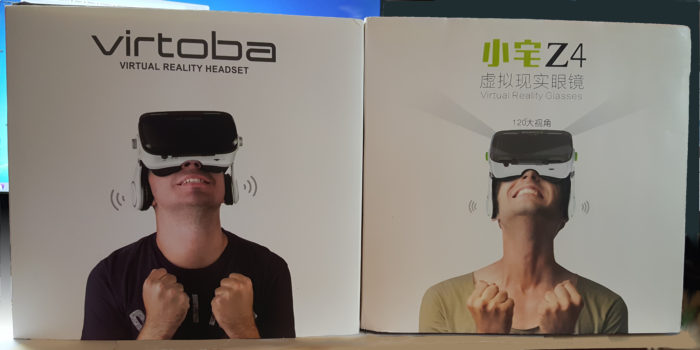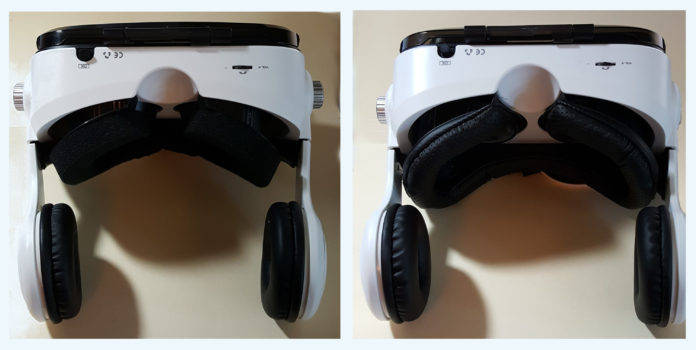Update: In August, I bought a FiiT VR 2S, and that is now my new favorite. But I’m also still recommending the BoboVR Z4 headset, because of its 120-degree field of view, built-in headphones, and built-in control button.
Last month, I received a free review copy of the Virtoba X5 headset from GeekBuying, and a couple of weeks later, the BoboVR Z4 that I ordered myself finally arrived.
You can read my review of the Virtoba X5 here. In the review, I used the names of the headsets interchangeably, since I though they were the same headset, sold under different brand names.
But now that I’ve got both of them in front of me, I decided to take a closer look.
On the surface, they do look very much alike.
Even the packaging looks identical.

But then, if you look closely, you’ll see differences. For example, even though the models are photographed in similar poses, those are clearly two different guys.
There are small differences on the headsets themselves, as well. For example, the white plastic of the headsets are a shade different.
Another very minor difference is the connector that plugs into the audio port of the smartphone, so you can listen through the headset’s headphones.

On the BoboVR Z4, the cord is longer, and is wound into a spiral. The Virtoba X5’s cord is straight, and shorter.
The control buttons on the bottom of the headsets also seem to be slight different. I liked the feel of the BoboVR one better — the Virtoba button seemed a tiny bit loose, though I wouldn’t have noticed anything if I hadn’t been going back and forth between the two headsets, comparing the buttons.
But the biggest difference is in the padding around the lenses.

The Virtoba X5 has spongy foam padding, while the BotoVR Z4 has a leathery look, a little bit like driving gloves.

The BoboVR Z4 padding, above, looks better. The opening is also a bit wider, leaving more room for glasses.

The Virtoba X5 padding is comfortable enough, but the opening is smaller, leaving less room for glasses. My glasses, for example, even though they are on the small side, dug into the foam, and when I tried wearing them with the headset anyway, they squished up against my eyeballs.
Both headsets had the same two minor issues that bugged me. First, the springy metal piece that holds the smartphone in place has only a tiny bit of material covering it, and it could damage the back of the smartphone if it wears off.
Second, the focal adjustment works by physically moving the part of the headset that holds the smartphone away or towards the lenses — instead of moving the lenses inside the headset, as other devices do. This means that if you have the focal distance at its maximum, say, and hold the headset tight, you will squeeze it back together and ruin the focus.
My advice, if you wear glasses, is to go with the BoboVR Z4. Otherwise, both seem fine, and if you want this style of headset, go for the one that has the best price or delivery times or bundled Bluetooth controller.
I was originally very excited about this headset — in either version. The field of view, the built-in headphones, the button. These are all unique or rare features in headsets in this or any other price range.
But now that I’ve had them around for a while, I’ve discovered that I don’t use them. I reach for the DeePoon instead, which doesn’t have built-in headphones, has a smaller field of view, and has no control button — but it is smaller so it takes up less space on my shelf, lighter, and is easier to use.
- OSCC 2024 Submission Deadline Approaching - October 19, 2024
- AvatarLife Viewer adds video calls, screen sharing - October 19, 2024
- Spooky season brings more visitors to OpenSim worlds - October 15, 2024
